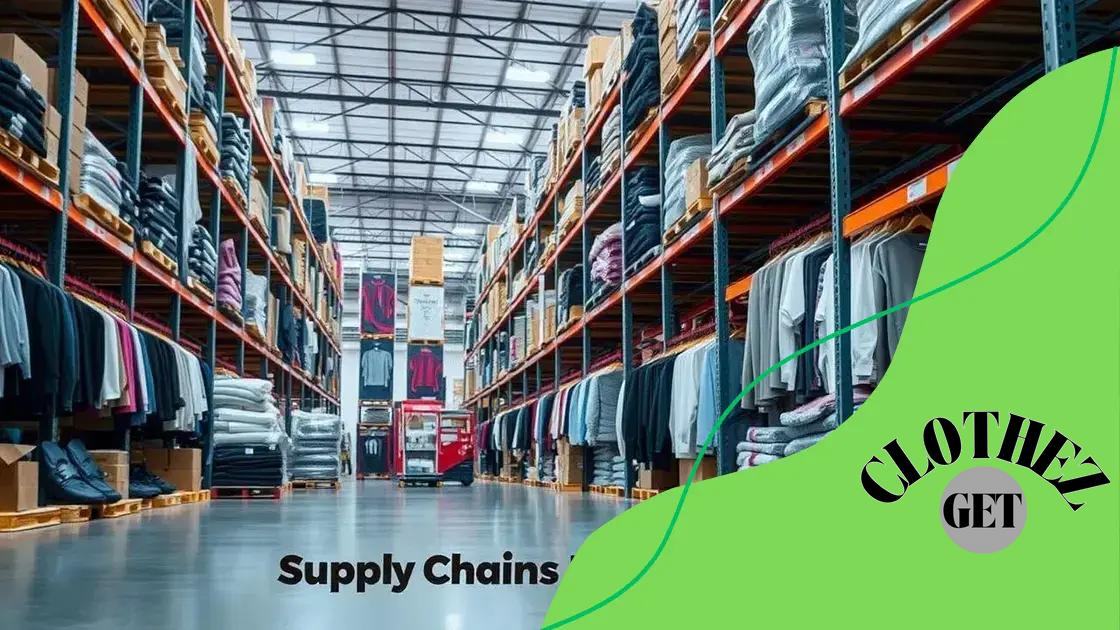Shein’s cost management during supply chain disruptions

Shein’s cost management during supply chain disruptions focuses on flexibility, technology integration, and diverse supplier networks, allowing the company to adapt quickly to challenges and maintain its competitive edge in the fast fashion industry.
Shein’s cost management during supply chain disruptions is a critical topic as it not only affects the company’s profitability but also its reputation. How does this fast-fashion giant navigate unexpected challenges while keeping costs in check? Let’s find out.
Understanding Shein’s supply chain model
Understanding Shein’s supply chain model is vital for grasping how the company maintains its competitive edge. Shein’s approach relies on agility and speed to meet the fast fashion demands of its customers.
This model is designed to minimize lead times while maximizing responsiveness to trends. The company achieves this through a combination of technology, partnerships, and innovative practices.
Key Elements of Shein’s Supply Chain
Several aspects contribute to the efficiency of Shein’s supply chain. These include:
- Data-driven decisions: Shein utilizes data analytics to forecast trends and consumer preferences accurately.
- Global partnerships: Collaborations with various suppliers allow Shein to source materials quickly and efficiently.
- Continuous improvement: The company constantly evaluates its processes to enhance speed and reduce costs.
Shein’s model employs a fast fashion methodology, which means they can produce clothing items rapidly, responding to market demands almost in real-time. This setup allows them to introduce new products within mere weeks, a feat that traditional retailers struggle to match.
Even more impressive is Shein’s ability to utilize social media for feedback. Customers share their thoughts on new items, enabling Shein to adapt its offerings immediately. This level of engagement keeps the brand relevant within a competitive space.
Technology Integration
An important factor in Shein’s supply chain is the integration of technology. Advanced software helps manage inventory, track orders, and analyze sales trends. This integration allows for greater transparency and efficiency.
In addition, automated systems in warehouses enable quick processing of orders. Such efficiency minimizes delays, ensuring customers receive their orders promptly.
Overall, Shein’s supply chain model showcases a revolutionary approach in the fashion industry. By combining speed, technology, and data analytics, the company not only meets but anticipates customer needs, making them a leader in fast fashion.
Key strategies for cost management in disruptions
Cost management is essential for companies like Shein, especially during disruptions. Implementing effective strategies allows them to maintain profit margins while adapting to challenges.
One of the primary strategies is to focus on flexibility. Being able to adjust production schedules and resources quickly is crucial when facing supply chain issues. This adaptability helps Shein respond to demand variations and unexpected delays without incurring excessive costs.
Diverse Supplier Network
Another key approach is to cultivate a diverse supplier network. By working with multiple suppliers, Shein mitigates risks associated with dependency on a single source.
- Reduce risk: With various suppliers, disruptions from one source can be offset by others.
- Negotiation power: A broad network improves Shein’s bargaining position for better prices and terms.
- Enhanced innovation: Collaborating with different suppliers encourages creative solutions and new materials.
Additionally, Shein relies on advanced technology to streamline operations and reduce costs. Employing analytics allows the company to track spending and identify savings opportunities effectively.
Investing in technology not only saves money but also improves decision-making. This gives Shein an edge, enabling swift responses to market shifts or disruptions.
Inventory Management Techniques
Effective inventory management is another vital strategy. Shein adopts just-in-time (JIT) inventory practices to limit excess stock while ensuring availability.
This approach helps reduce storage costs and minimizes waste. It allows Shein to adapt quickly to changes in consumer preferences while keeping expenses low.
In summary, cost management during disruptions is multifaceted. By focusing on flexibility, leveraging a diverse supplier network, and utilizing technology, Shein effectively navigates challenges while maintaining profitability.
The role of technology in Shein’s approach

The role of technology in Shein’s approach is crucial for its operations and success in the fast fashion industry. By leveraging advanced tech solutions, Shein enhances efficiency and responsiveness.
One major component is the use of data analytics. This technology allows Shein to monitor trends and customer preferences effectively. By analyzing data patterns, the company can quickly adjust its production and inventory to match current demands.
Automation in Warehousing
Automation plays a vital role in Shein’s supply chain. The company uses automated systems in warehouses to streamline order processing. This setup minimizes human error and speeds up fulfillment, ensuring customers receive their products promptly.
- Efficient inventory management: Automated systems track stock levels in real-time, allowing Shein to maintain optimal inventory levels.
- Faster order processing: Automation greatly reduces the time between order placement and delivery.
- Cost reduction: With fewer manual operations, overhead costs decrease, benefiting the overall financials.
Moreover, Shein integrates artificial intelligence (AI) to personalize the shopping experience. AI tools help analyze customer behavior, allowing Shein to recommend products tailored to individual preferences.
This personalized approach increases customer satisfaction and retention rates. As Shein continues to innovate, its reliance on technology remains a key factor in addressing challenges and staying ahead in a competitive market.
Supply Chain Management Tools
Shein also utilizes sophisticated supply chain management tools. These technologies aid in planning, logistics, and overall coordination of product flow. By optimizing these processes, Shein reduces delays and enhances service levels.
Using technology in this way allows Shein to react swiftly to any supply chain disruptions. This agility is essential in the ever-changing landscape of fashion.
Overall, Shein’s integration of technology not only streamlines operations but also creates a more engaging and responsive shopping experience, cementing its position as a leader in the fast fashion market.
Case studies of Shein during crisis periods
Case studies of Shein during crisis periods illustrate how the brand adapts and thrives even in challenging times. By examining specific instances, we can gain insights into their effective strategies and resilience.
One notable example occurred during the global pandemic, which disrupted supply chains worldwide. Many retailers faced significant challenges, yet Shein leveraged its agile supply chain model to navigate these difficulties. The ability to quickly pivot production and logistics enabled Shein to continue meeting customer demands while others struggled.
Adapting to Global Crises
Throughout these times, Shein employed several key strategies:
- Increased digital marketing: As physical stores closed, Shein boosted its online presence, engaging customers through social media and targeted ads.
- Flexible supply chain management: By adjusting its supplier network and production schedules, Shein maintained a steady flow of new inventory.
- Customer engagement: Shein enhanced its communication with customers, providing updates and promoting new arrivals, keeping shoppers interested.
Another example is during natural disasters that impact logistics. For instance, during floods or hurricanes, Shein has demonstrated rapid response capabilities. They rerouted shipments and adjusted manufacturing locations to ensure minimal delays in product delivery.
By maintaining strong relationships with a diverse supplier base, Shein mitigated risks associated with these disruptions. The diverse network provided options that were not available to competitors reliant on single-source suppliers.
Learning from Past Disruptions
These case studies highlight how Shein uses past experiences to inform future strategies. Each crisis offers lessons that help refine their approach to risk management.
By continuously analyzing performance during disruptions, Shein can enhance its processes and prepare better for future challenges. This proactive mindset keeps the brand resilient and adaptable, which is essential in the fast-paced fashion industry.
Overall, examining Shein’s response to crises reveals a commitment to innovation and responsiveness that sets the brand apart from its competitors.
Future implications for Shein’s supply chain
The future implications for Shein’s supply chain are significant as the fashion industry continues to evolve. Adapting to new challenges is crucial for maintaining competitive advantage.
As sustainability gains importance, Shein is expected to shift focus towards more eco-friendly practices. This change may involve sourcing sustainable materials and implementing waste-reduction strategies. By embracing sustainability, Shein can appeal to environmentally-conscious consumers, enhancing its brand image.
Technological Advancements
Technological enhancements will also shape Shein’s supply chain in the future. Artificial intelligence and machine learning can lead to more efficient inventory management and demand forecasting.
- Predictive analytics: Using data to anticipate trends will help Shein reduce overproduction and streamline processes.
- Automation: Implementing more automated systems in warehouses can improve fulfillment speeds and accuracy.
- Blockchain technology: This could enhance transparency in the supply chain, giving consumers insight into the sourcing of their products.
Additionally, the globalization of supply chains poses both opportunities and challenges. While global partnerships can expand product offerings, they also require Shein to manage risks associated with international disruptions.
Another implication is the evolving consumer behavior, particularly the demand for quick delivery times. Shein will need to further optimize its logistics to ensure that it can meet these expectations without sacrificing quality or increasing costs.
Adapting to Regulatory Changes
As regulations surrounding labor practices and environmental impact tighten, Shein must proactively adapt its supply chain strategies. Compliance with these regulations will be essential to avoid penalties and maintain operational integrity.
Staying informed about changing regulations and consumer expectations will help Shein navigate the future landscape of fashion retail effectively. By prioritizing scalability and flexibility in its supply chain, Shein can ensure resilience against future challenges.
In conclusion, Shein’s innovative supply chain strategies, including technology integration and crisis management, reveal their ability to adapt in a rapidly changing environment. By focusing on sustainability and flexibility, Shein positions itself for future growth. The insights gained from crisis case studies and emerging consumer trends will be vital for maintaining its competitive edge. Overall, Shein demonstrates how a big brand can navigate challenges while continuing to thrive in the fast fashion industry.
FAQ – Frequently Asked Questions about Shein’s Supply Chain
How does Shein ensure sustainability in its supply chain?
Shein is shifting towards eco-friendly practices by sourcing sustainable materials and implementing waste-reduction strategies to appeal to environmentally-conscious consumers.
What technology does Shein use to enhance its operations?
Shein leverages data analytics, artificial intelligence, and automation to improve inventory management, demand forecasting, and order processing efficiency.
How does Shein respond to consumer trends?
Shein adapts to consumer demands for quick delivery by optimizing its logistics and enhancing communication through digital marketing.
What lessons has Shein learned from previous crises?
Shein learned the importance of flexibility and maintaining a diverse supplier network, enabling the brand to quickly adjust to disruptions and continue meeting customer demands.





